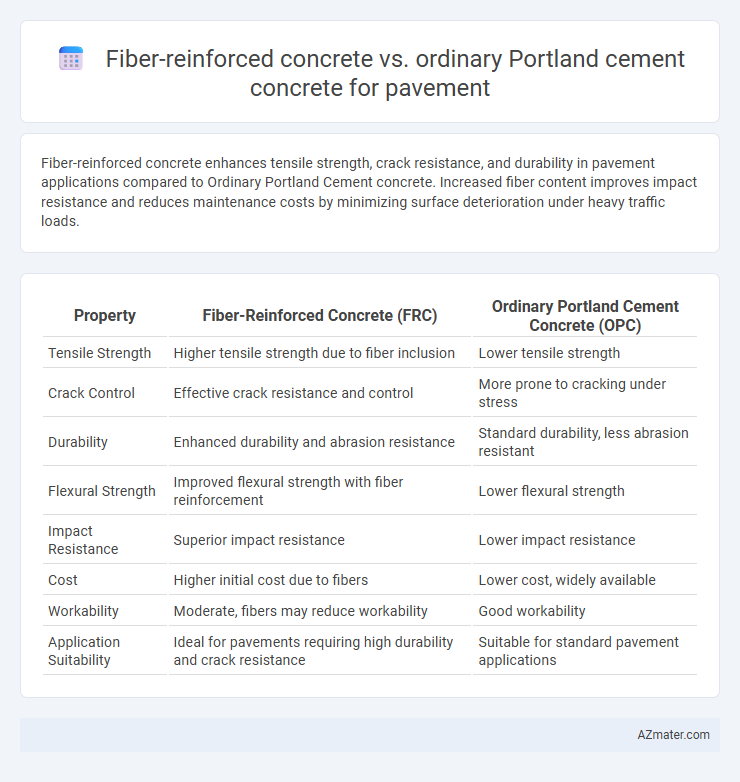Fiber-reinforced concrete enhances tensile strength, crack resistance, and durability in pavement applications compared to Ordinary Portland Cement concrete. Increased fiber content improves impact resistance and reduces maintenance costs by minimizing surface deterioration under heavy traffic loads.
Table of Comparison
| Property | Fiber-Reinforced Concrete (FRC) | Ordinary Portland Cement Concrete (OPC) |
|---|---|---|
| Tensile Strength | Higher tensile strength due to fiber inclusion | Lower tensile strength |
| Crack Control | Effective crack resistance and control | More prone to cracking under stress |
| Durability | Enhanced durability and abrasion resistance | Standard durability, less abrasion resistant |
| Flexural Strength | Improved flexural strength with fiber reinforcement | Lower flexural strength |
| Impact Resistance | Superior impact resistance | Lower impact resistance |
| Cost | Higher initial cost due to fibers | Lower cost, widely available |
| Workability | Moderate, fibers may reduce workability | Good workability |
| Application Suitability | Ideal for pavements requiring high durability and crack resistance | Suitable for standard pavement applications |
Introduction to Fiber-Reinforced Concrete and Ordinary Portland Cement Concrete
Fiber-reinforced concrete (FRC) incorporates dispersive fibers such as steel, glass, or synthetic materials to enhance tensile strength, crack resistance, and durability in pavement applications. Ordinary Portland Cement (OPC) concrete relies primarily on cement hydration to achieve compressive strength but lacks inherent reinforcement against tensile stresses, leading to susceptibility to cracking under load. The inclusion of fibers in FRC significantly improves impact resistance and longevity compared to traditional OPC concrete, making it a preferred choice for high-performance pavement structures.
Composition and Material Characteristics
Fiber-reinforced concrete (FRC) incorporates synthetic or steel fibers into Ordinary Portland Cement (OPC) concrete to enhance tensile strength, crack resistance, and durability for pavement applications. OPC concrete consists primarily of cement, water, fine and coarse aggregates, resulting in high compressive strength but lower tensile capacity and ductility compared to FRC. The addition of fibers in FRC improves material toughness and controls different crack types, making it suitable for pavements subjected to heavy loads and repeated traffic stress.
Mechanical Properties: Strength and Durability
Fiber-reinforced concrete (FRC) exhibits significantly enhanced tensile strength, flexural strength, and crack resistance compared to Ordinary Portland Cement Concrete (OPCC), resulting in improved load-bearing capacity and reduced surface wear for pavements. The inclusion of fibers such as steel, glass, or synthetic materials increases impact resistance and toughness, leading to superior durability under cyclic traffic loads and environmental stress. FRC also demonstrates reduced shrinkage and improved resistance to freeze-thaw cycles, corrosive chemicals, and abrasion, extending pavement service life beyond that of conventional OPCC.
Crack Resistance and Flexural Performance
Fiber-reinforced concrete (FRC) significantly enhances crack resistance and flexural performance compared to Ordinary Portland Cement (OPC) concrete in pavement applications, due to the incorporation of synthetic or steel fibers that distribute stress and control crack propagation. FRC exhibits higher tensile strength and improved durability under repeated loading, reducing maintenance costs and extending pavement service life. The flexural strength of fiber-reinforced concrete can be increased by 20-30%, providing better resistance to bending and deformation under traffic loads than conventional OPC concrete.
Construction Practices and Workability
Fiber-reinforced concrete (FRC) enhances pavement durability by incorporating synthetic or steel fibers, which improve tensile strength and control cracking during construction, but it demands specialized mixing and placement techniques to ensure uniform fiber distribution. Ordinary Portland cement (OPC) concrete offers straightforward batching and finishing processes, known for its ease of handling and consistent workability, making it suitable for conventional pavement applications. While FRC requires adjustments in vibration and curing methods to optimize fiber integration and surface finish, OPC concrete is compatible with standard construction practices, resulting in faster placement and reduced labor complexity.
Cost Analysis and Economic Considerations
Fiber-reinforced concrete (FRC) typically incurs higher initial costs than ordinary Portland cement concrete (OPC) due to the expenses associated with synthetic or steel fibers. However, FRC offers enhanced durability, reduced maintenance frequency, and extended pavement lifespan, which can lead to lower life-cycle costs over time. Economic considerations must balance upfront investment against long-term savings from fewer repairs and improved performance in heavy-traffic pavement applications.
Environmental Impact and Sustainability
Fiber-reinforced concrete (FRC) enhances pavement durability by reducing cracking and extending service life, leading to lower maintenance frequency and resource consumption compared to Ordinary Portland Cement (OPC) concrete. The inclusion of fibers in FRC contributes to improved structural efficiency, allowing for thinner pavements and reduced cement usage, which significantly decreases carbon emissions associated with cement production. Sustainable pavement design increasingly favors FRC due to its potential in minimizing environmental impact through enhanced lifespan and optimized material utilization.
Maintenance Requirements and Longevity
Fiber-reinforced concrete (FRC) for pavement significantly reduces maintenance requirements due to its enhanced crack resistance and improved load-bearing capacity, leading to fewer repairs over time. Ordinary Portland cement concrete (OPCC) pavements typically experience more frequent surface cracking and deterioration, increasing maintenance interventions and associated costs. The longevity of FRC pavements surpasses OPCC, offering extended service life through superior durability against environmental stress and fatigue.
Typical Applications in Pavement Engineering
Fiber-reinforced concrete (FRC) is widely used in pavement engineering for applications requiring enhanced crack resistance and durability, such as airport runways, bridge decks, and industrial floors. Ordinary Portland cement concrete (OPCC) remains the standard for typical road pavements and highway surfaces due to its cost-effectiveness and well-established performance history. FRC's improved tensile strength and impact resistance make it ideal for heavy-traffic areas and pavements subjected to dynamic loading conditions.
Comparative Summary and Recommendations
Fiber-reinforced concrete (FRC) exhibits superior tensile strength, crack resistance, and durability compared to Ordinary Portland Cement (OPC) concrete in pavement applications, resulting in enhanced load-bearing capacity and reduced maintenance costs. Despite higher initial material expenses, FRC offers longer service life and better performance under heavy traffic and environmental stress, making it a cost-effective solution for long-term infrastructure investment. For pavements requiring enhanced durability and lifecycle performance, especially in high-traffic or harsh climates, fiber-reinforced concrete is recommended over conventional OPC concrete.

Infographic: Fiber-reinforced concrete vs Ordinary Portland cement concrete for Pavement
 azmater.com
azmater.com